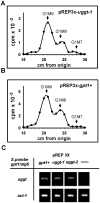The two Caenorhabditis elegans UDP-glucose:glycoprotein glucosyltransferase homologues have distinct biological functions
- PMID: 22073243
- PMCID: PMC3206904
- DOI: 10.1371/journal.pone.0027025
The two Caenorhabditis elegans UDP-glucose:glycoprotein glucosyltransferase homologues have distinct biological functions
Abstract
The UDP-Glc:glycoprotein glucosyltransferase (UGGT) is the sensor of glycoprotein conformations in the glycoprotein folding quality control as it exclusively glucosylates glycoproteins not displaying their native conformations. Monoglucosylated glycoproteins thus formed may interact with the lectin-chaperones calnexin (CNX) and calreticulin (CRT). This interaction prevents premature exit of folding intermediates to the Golgi and enhances folding efficiency. Bioinformatic analysis showed that in C. elegans there are two open reading frames (F48E3.3 and F26H9.8 to be referred as uggt-1 and uggt-2, respectively) coding for UGGT homologues. Expression of both genes in Schizosaccharomyces pombe mutants devoid of UGGT activity showed that uggt-1 codes for an active UGGT protein (CeUGGT-1). On the other hand, uggt-2 coded for a protein (CeUGGT-2) apparently not displaying a canonical UGGT activity. This protein was essential for viability, although cnx/crt null worms were viable. We constructed transgenic worms carrying the uggt-1 promoter linked to the green fluorescent protein (GFP) coding sequence and found that CeUGGT-1 is expressed in cells of the nervous system. uggt-1 is upregulated under ER stress through the ire-1 arm of the unfolded protein response (UPR). Real-time PCR analysis showed that both uggt-1 and uggt-2 genes are expressed during the entire C. elegans life cycle. RNAi-mediated depletion of CeUGGT-1 but not of CeUGGT-2 resulted in a reduced lifespan and that of CeUGGT-1 and CeUGGT-2 in a developmental delay. We found that both CeUGGT1 and CeUGGT2 play a protective role under ER stress conditions, since 10 µg/ml tunicamycin arrested development at the L2/L3 stage of both uggt-1(RNAi) and uggt-2(RNAi) but not of control worms. Furthermore, we found that the role of CeUGGT-2 but not CeUGGT-1 is significant in relieving low ER stress levels in the absence of the ire-1 unfolding protein response signaling pathway. Our results indicate that both C. elegans UGGT homologues have distinct biological functions.
Conflict of interest statement
Figures












References
-
- Trombetta SE, Parodi AJ. Purification to apparent homogeneity and partial characterization of rat liver UDP-glucose:glycoprotein glucosyltransferase. J Biol Chem. 1992;267:9236–9240. - PubMed
-
- Guerin M, Parodi AJ. The UDP-glucose:glycoprotein glucosyltransferase is organized in at least two tightly bound domains from yeast to mammals. J Biol Chem. 2003;278:20540–20546. - PubMed
Publication types
MeSH terms
Substances
Grants and funding
LinkOut - more resources
Full Text Sources
Molecular Biology Databases
Research Materials
Miscellaneous

